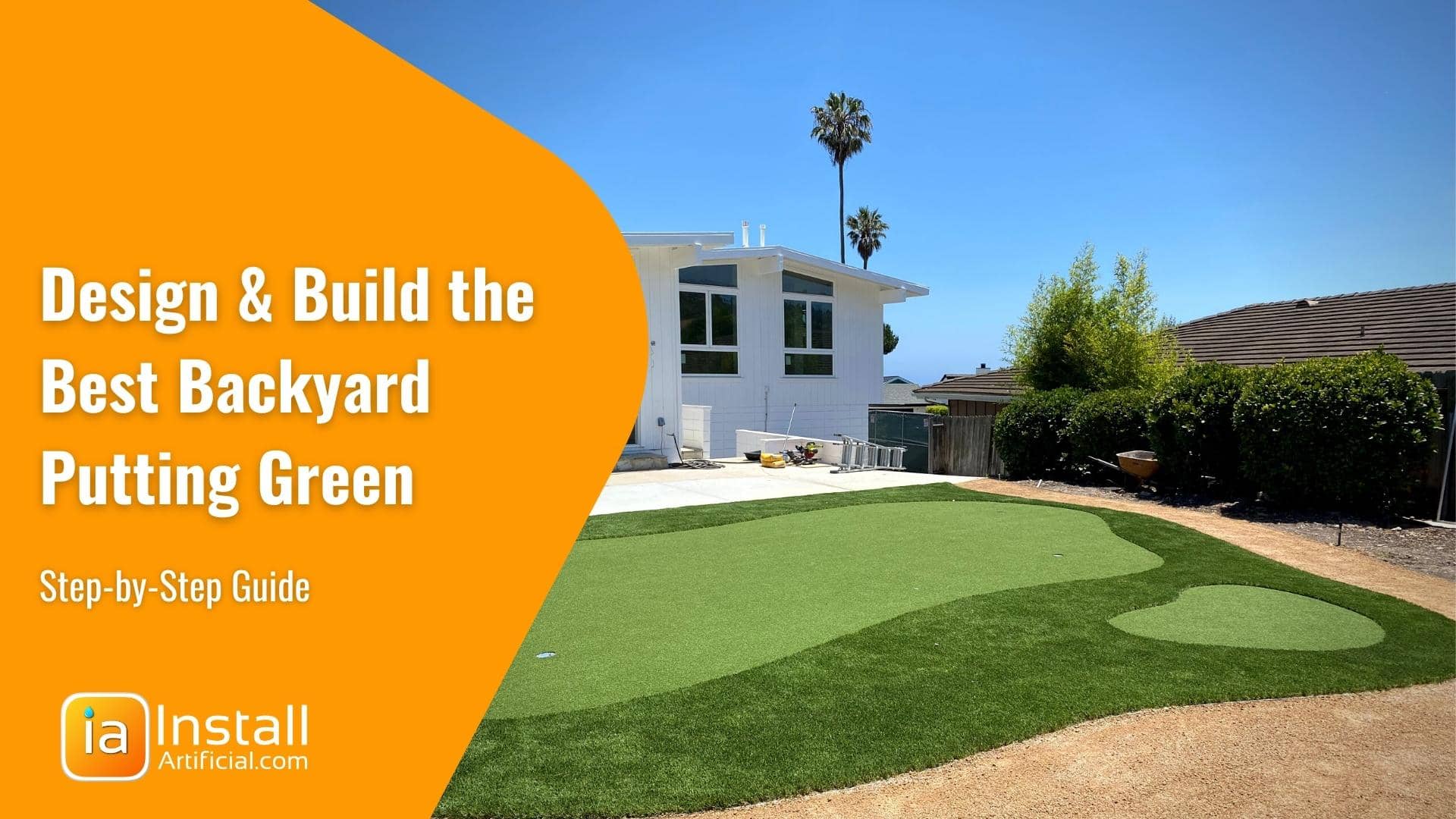
Building, designing, and customizing a synthetic putting green in your backyard can be just as exciting as actually playing on it. Embrace this project and make sure...
When people search for putting green installation near me, it is important to distinguish a professional and experienced putting green installer from an inexperienced team. We created an easy checklist to reference. Rely on this list to interview local putting green installers and supervise your projects, as this is our basic checklist for our projects as well.
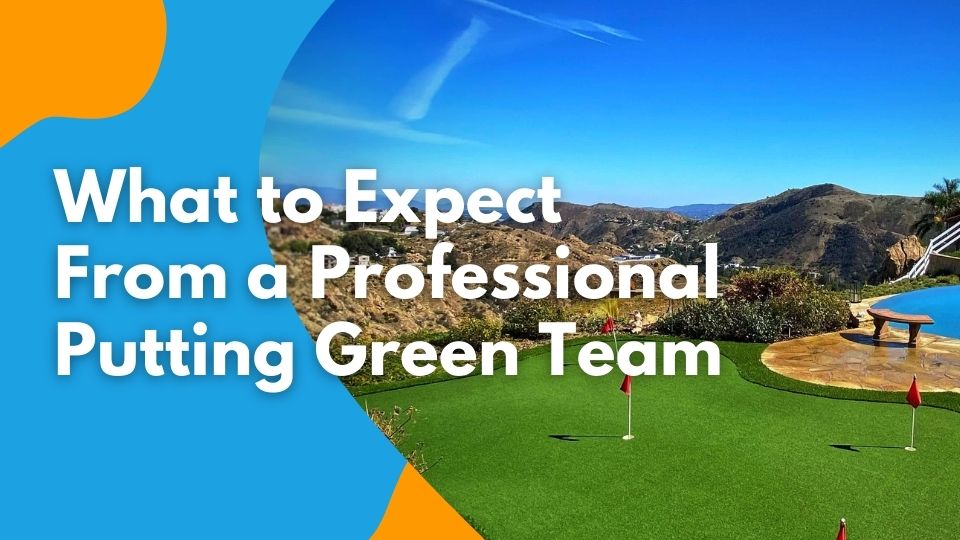
Prior to breaking ground, a putting green project requires meticulous planning. Depending on your gameplay, you can design dips, contours, and other obstacles to challenge yourself even more. Make sure that you and your installer discuss design so that you're green is fully customized to your liking.
Before you start searching for putting green turf near me, first inspect the soil to determine how to prepare the base. Some projects require additional excavation and compaction or weed prevention. When neglected, the entire site becomes hilly or attacked by aggressive weeds, ruining the job in just a few years. While it is impossible to foresee all weed growth, it is important to watch out for gophers and bamboo growth.
Build a putting green surface that matches the skill and design perception of the player. We often see putting greens where the ball is placed on the surface and rolls by itself due to incomplete grading. Also, not spending the time with the client to meet their specific needs can result in the area being just flat and boring, or the surface being too challenging to play. Sand bunkers, ponds, and other obstacles can be installed to customize gameplay. Stimp speed can also be adjusted to customize gameplay.
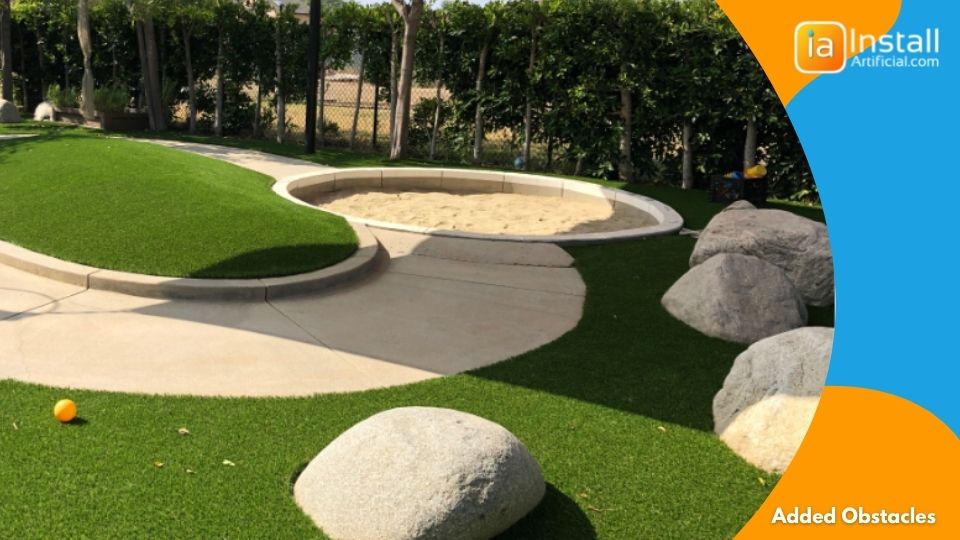
Contours may seem like a trivial aspect, but they play a crucial role in enhancing the overall golfing experience. When considering contours, envision yourself on the course, taking each stroke and navigating the terrain. Walk the field, immerse yourself in the game, and determine if it offers the experience you desire.
Collaboration and communication are crucial when it comes to ensuring a smooth and timely installation process. By establishing a shared installation schedule, both parties can easily agree on the approval of different stages without any disruptions to the project. Additionally, it is important to have open discussions about the shape of the surface and contours to ensure they meet your specific requirements. To get started with InstallArtificial and kickstart your project, simply request an estimate below!
Discover our expert tips and recommendations for installing an artificial putting green! Gain a deeper understanding of each step involved so you can have an informed discussion with your backyard contractor.
Our putting green base preparation involves a carefully crafted combination of three essential layers: road base, decomposed granite, and sand.
Compact the area by moving in circular motions in both directions. Make sure to overlap the compacted path by at least 30% for optimal results.
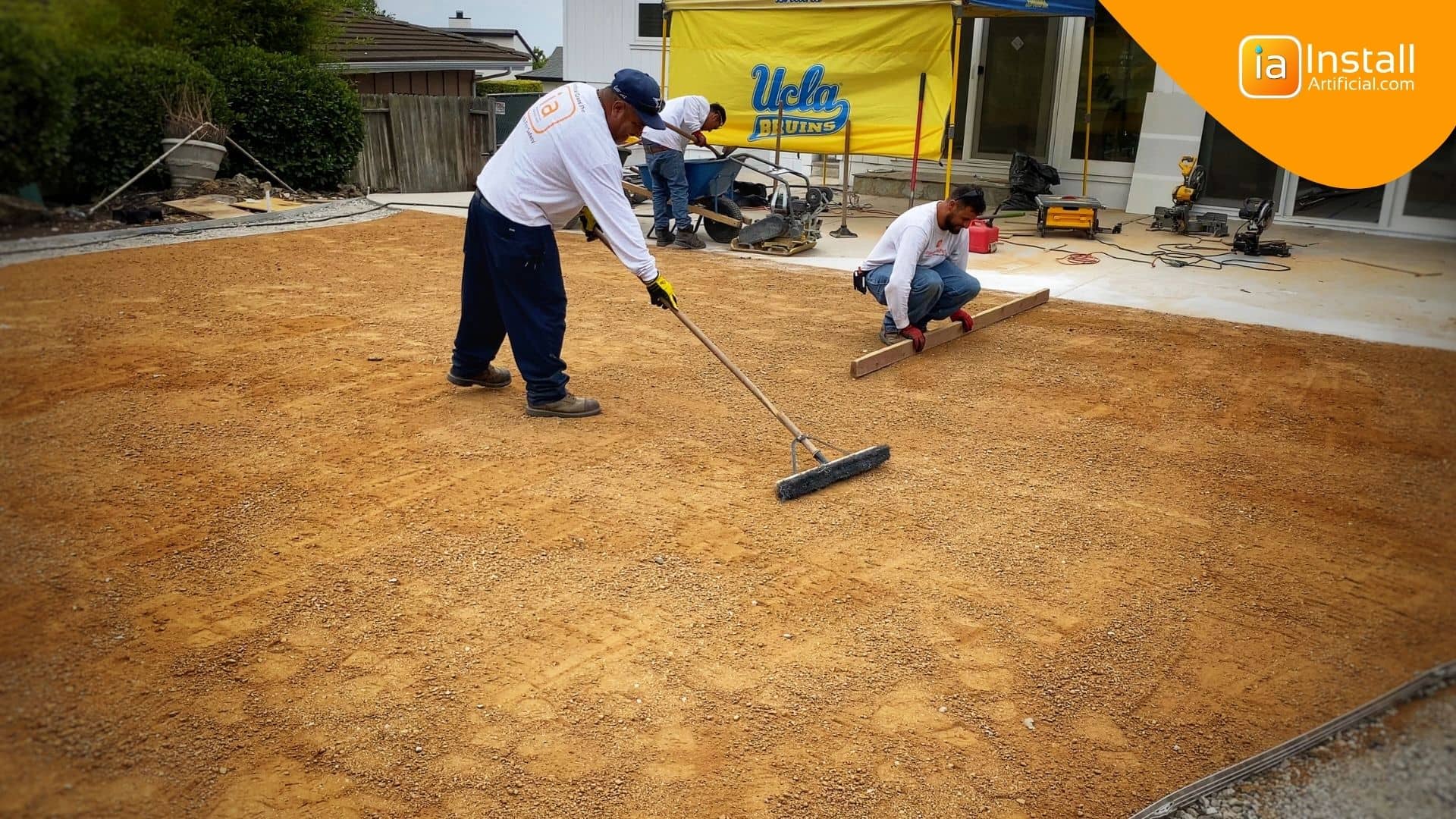
Grading with an eye may seem like it looks good, but there are a few tools and approaches that make grading much, much better. Make sure your installers are utilizing professional tools when grading the area. An expert putting green installation crew will be able to provide a smooth contoured surface, whereas a cheap crew may sloppily compact and grade. This will affect how the golf ball rolls.
Utilize Laser Level
Determine the key levels when working with elevation or rely on fundamental objects such as the flood level of a house, concrete, and tops of the fence. A laser is mostly used on commercial or vast projects where angles are critical.
Holes and plastic cups for putting greens are installed in concrete for durability, cleaning, and drainage. This crucial step ensures that the cups are securely anchored in place, allowing for a smooth and reliable putting experience. By installing the cups in concrete, they are able to withstand the impact of golf balls without shifting or becoming damaged. This not only increases the longevity of the putting green but also reduces the need for frequent repairs or replacements.
Wrinkles are a frequent issue that plagues artificial putting greens. In fact, it's not uncommon to spot wrinkles on projects that are showcased by certain companies. To combat this problem and ensure a smooth and flawless surface, we employ the following techniques:
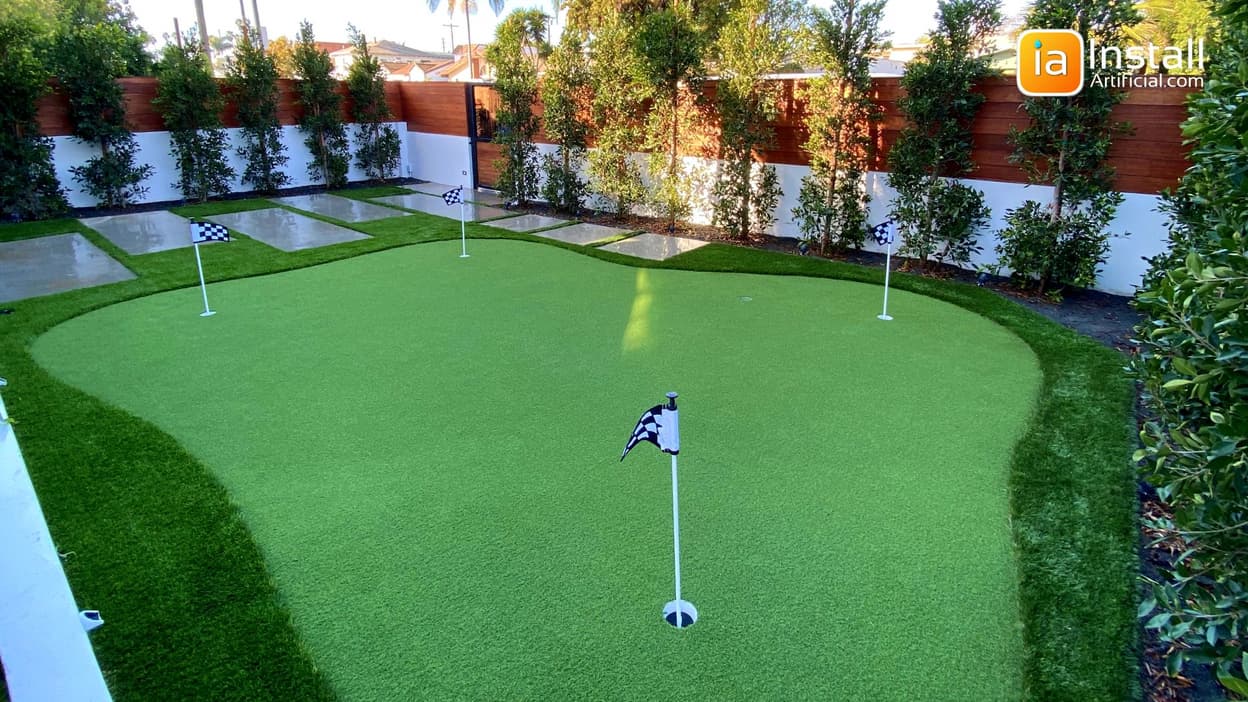
Properly anchoring nails to the base is crucial for a seamless and professional look. Additionally, it is important to minimize the visibility of seams to create a flawless appearance. When installers cut and seam putting green materials, they carefully lift the grass blades on both sides of the seam. To ensure a seamless finish, it is essential to gently push the grass blades back down, effectively reducing the visibility of the seam.
When selecting artificial grass to accurately mimic a true putting green, it is crucial to opt for a specific type that replicate the characteristics of real grass. To achieve this, you should choose an artificial grass with a short pile height of approximately half an inch.
Different textures of putting green grass can affect the stimp speed and ball roll, so make sure you're selecting the right surface for your preferences. It's important to note that the presence or absence of infill in the product can also impact the speed at which the ball rolls. Artificial grass with infill will result in a faster ball roll, while products without infill will produce a slower ball roll.
Therefore, to authentically replicate a putting green experience in your backyard, consider these factors when selecting the type of artificial grass for your project.
When considering the durability of putting green turf, it is essential to evaluate various factors related to its usage and household conditions. To determine the level of durability needed, ask yourself the following questions:
1. Frequency of use: How often will your putting green be utilized? Will it be in daily practice, occasional use, or something in between? Understanding the frequency of use will help determine the wear and tear the turf will experience.
2. Users: Identify who will be using the putting green. Are they experienced golfers, beginners, or a mix of both? This information will help assess the potential impact on the turf from different skill levels and practices.
3. Family dynamics: Consider the presence of children in your household who may play and run on the turf. Additionally, evaluate if you have any pets, such as dogs, who might interact with the putting green. The activity levels and size of these family members will influence the turf's durability requirements.
4. Pet activity: If you have dogs, assess how active they are. Some dogs may be more prone to digging, running, or causing damage to the turf. Understanding their behavior will help determine the necessary durability and resilience of the turf.
By thoroughly evaluating these factors and any others relevant to your specific household, you can better determine the required level of durability for your putting green turf. This will ensure that it can withstand the wear and tear created by your household's unique usage patterns and maintain its optimal condition over time.
When selecting a high-quality putting green turf installation, there are several important characteristics to consider:
1. Durability: Assess the level of foot traffic your putting green will receive. Determine how often it will be used for practice, whether it's daily or weekly. If you have children or dogs who will be running and playing on the turf, consider their activity level and size. This information will help you choose a turf product that can handle the expected usage and remain durable over time.
2. Realistic Putting Experience: Opt for artificial grass that closely mimics the texture and performance of a real putting green. It should provide a consistent, smooth surface to ensure your practice translates well to real golf courses. Look for a short pile height, around half an inch, which is suitable for putting. Keep in mind that using infill in the turf can increase ball speed, while opting for no infill can slow it down.
3. Customizable Design: Let your creativity shine when planning the layout of your putting green. While a simple strip of artificial grass with a hole is an option, consider incorporating existing features of your yard such as slopes, trees, berms, or ponds to create a more challenging and visually interesting golf hole. With artificial turf, the design possibilities for your putting green are virtually limitless, allowing you to tailor it to your preferences and skill level.
4. Low Maintenance: Although maintaining artificial turf is easier compared to natural grass, some upkeep is still necessary to keep it looking its best. If you choose a turf product with infill, occasional replenishment may be required as it can disperse over time. Additionally, removing leaves, twigs, and debris using a leaf blower or broom is essential. Due to the short pile height of putting green turf, you may not need to fluff the fibers with a power broom.
5. Trusted and Experienced Installers: Selecting a reliable and reputable artificial grass installation company is crucial for a successful putting green installation. Uneven spots or a single divot can greatly impact the playability of your green. Look for installers with a demonstrated track record of installing putting greens specifically. Don't hesitate to read reviews from multiple sources to ensure consistency in their work. A trustworthy installer should be willing to address your concerns, answer any questions, and guide you through every step of the installation process.
Infill plays a crucial role in maintaining the upright position of synthetic turf fibers and contributing to a realistic appearance. By adding weight to the artificial grass, infill effectively prevents the formation of wrinkles, warping, and shifting over time. It accomplishes this by keeping the fibers grounded and preventing them from becoming misaligned or flattened.
There are various types of infill available, with most of them being natural materials. Some common examples include sand, cork, walnut shells, and ziolite. The infill material, such as rounded silica sand in installations, serves to further enhance the realism of the turf, mimicking the properties of natural grass.
By filling the spaces between the synthetic turf fibers, infill assists in maintaining their upright position even under heavy use. This, in turn, ensures that the turf retains its original shape and appearance, providing a more natural and visually pleasing aesthetic. Additionally, infill promotes durability by reinforcing the overall structure of the synthetic turf, making it more resistant to wear and tear.
Infill material is an essential component used in synthetic grass products to serve multiple purposes. Firstly, it aids in maintaining the uprightness of the turf fibers and ensuring they can withstand the wear and tear of regular use. Similar to how soil supports the growth of natural grass, infill plays a crucial role in keeping the artificial turf looking realistic and feeling natural. Additionally, infill adds weight to the artificial grass, preventing the development of wrinkles, warping, and shifting over time.
Various types of infill materials are available, and most are derived from natural sources. Some common examples include sand, cork, walnut shells, and zeolite.
When selecting the ideal putting green turf products for your backyard, several factors should be taken into consideration. By evaluating and comparing these features, you can make an informed decision:
1. Research: Start by conducting thorough research on the various types of artificial grass available in the market. Just like on a golf course, different species, thicknesses, and heights of artificial grass are suitable for different purposes. Explore different options and consult experts to determine which products will perform well and which are the best suited for a putting green.
2. Terminology: Familiarize yourself with the terminology used in the artificial turf industry. Understanding the specifications and terms will help you identify the right products for your backyard putting green.
3. Yarn Fibers: Consider the types of yarn fibers used in the artificial grass. Common options include Polyethylene, Polypropylene, and Nylon. Each type has different characteristics, so choose the one that meets your specific requirements.
4. Thatch: Thatch mimics the natural progression of dead and dying grass beneath the actively growing grass. It adds a cushioning effect to synthetic turf. Look for artificial grass with an appropriate amount of thatch for optimal playability.
5. Density: Consider the density of the turf product, which refers to the number of stitches per square meter. A more dense product generally indicates higher quality and durability. Opting for a denser turf will provide better performance and longevity.
6. Face Weight: Pay attention to the face weight, which only includes the weight of the yarn and thatch. Higher face weight implies more material, resulting in better durability. Selecting a turf with a higher face weight can ensure it can withstand frequent use.
7. Pile Height: The pile height refers to the height of the synthetic turf fibers. When it comes to putting green turf, an abnormally short pile height is necessary for a smooth and realistic ball roll.
8. Turf Backing: Assess the quality of the turf backing, including the primary and secondary backing. A durable turf backing is essential for the longevity and stability of the putting green turf.
9. Drainage: Putting green turf may have different drainage requirements compared to other artificial grass. While the small square footage of the green often mitigates drainage issues, it is still important to ensure proper drainage to maintain the playability and integrity of the surface.
10. Color: Artificial grass now comes in a wide variety of colors. Consider selecting a color that coordinates well with the neighboring natural lawns, ensuring a visually cohesive landscape.
By carefully considering these factors, you will be able to choose the best putting green turf product for your backyard, enhancing your golfing experience.
The color of artificial grass plays a crucial role in enhancing its realistic look. In order to mimic the appearance of various species of grass, artificial turf is carefully designed to closely match the colors found in natural lawns. Unlike natural grass, where not all blades are the exact same color, high-quality synthetic turf incorporates multiple shades of yarn. These variations in color help to replicate the natural inconsistencies seen in real grass, resulting in a more authentic and lifelike aesthetic. By incorporating a diverse range of colors, artificial grass creates a visually convincing illusion that seamlessly blends with the surrounding natural lawns, thereby contributing significantly to its overall realistic appearance.
Putting green turf has unique drainage qualities compared to other types of artificial grass. Generally, it does not drain in the same manner as regular artificial grass. However, the relatively small size of the putting green usually makes this less of a major concern.
Density in turf products indicates the number of stitches per square meter that the material contains. It serves as a measure of quality, with a higher density typically indicating a better-quality product. A turf product with higher density is capable of absorbing friction caused by foot traffic more effectively than one with lower density. As a result, it tends to be more durable over time. In essence, density serves as an indication of the strength and longevity of the turf product.
The base materials typically employed in the construction of artificial grass are primarily Polyethylene, Polypropylene, and Nylon.
Polyethylene is predominantly used in the turf's backing rather than the yarn fibers themselves. When it comes to fake grass specifically designed for putting greens, the materials of choice are usually polypropylene or nylon, with each offering its own advantages.
Nylon, although comparatively more costly, is known for its exceptional durability. Consequently, the best artificial grass products for putting green applications often utilize nylon fibers. On the other hand, polypropylene closely mimics the appearance and texture of natural grass, though it is more prone to matting and developing ruts when compared to nylon.
Pile height refers to the height at which the synthetic turf fibers of putting green turf stand. When it comes to putting green turf, the pile height plays a crucial role in replicating the characteristics of a real putting green. Unlike using synthetic turf for aesthetic purposes, the goal with putting green turf is to simulate the physics of a genuine putting surface rather than emphasizing visual appeal.
To achieve this, it is of utmost importance to have a significantly shorter pile height for putting green turf. The reason behind this lies in the impact on the short game. A shorter pile height allows the golf ball to roll more smoothly and consistently across the surface, closely resembling the ball's behavior on a natural putting green. On the other hand, using longer pile heights could adversely affect the precision and accuracy of a golfer's short game, making it less realistic and potentially impeding their performance.
Face weight refers to the measurement of the weight of the yarn and thatch present in a turf, excluding the backing material. It plays a crucial role in determining the quality of the turf and its ability to withstand wear and tear.
A higher face weight indicates that there is more material in the turf, making it more resistant to damage caused by heavy use and foot traffic. When a turf has a high face weight, it means that there is a greater density of fibers in the design. This density contributes to the turf's durability, as it provides more material to absorb the impact of regular use and minimizes the appearance of wear over time. Therefore, high-quality turf products tend to have a face weight of 60 ounces per square yard of material or higher.
On the other hand, turfs with low face weights may appear and feel threadbare or cheaply made. With less material to distribute the stress of usage, these turfs are more prone to flattened or matted fibers, resulting in a less appealing and less durable surface. Additionally, low face weight turfs may not be able to withstand heavy foot traffic and might show signs of wear and tear more quickly.
There are various types of artificial grass available on the market today, each designed to cater to different needs and purposes. Just like on a golf course, different species, thicknesses, and heights of artificial grass can be chosen based on specific requirements.
One type of artificial grass commonly used for home golf and putting greens is specifically designed to mimic the appearance and feel of natural grass on a putting green. This type of artificial grass is kept at the exact right height, providing a smooth putting surface that remains beautifully green throughout the year. With this option, you can have a pristine putting green in your backyard without the need for constant mowing or fertilizers.
In addition to putting greens, there are other types of artificial grass suitable for various applications. There are different types of artificial grass for playgrounds, pet areas, and balconies. Some artificial grass varieties are designed to resemble natural grass found in the rough, providing a more rugged and natural look.
Also, artificial grass options vary in terms of thickness. Some varieties are thicker and denser, which not only provides a more plush and luxurious feel underfoot but also aids in cushioning falls, making it suitable for playgrounds or areas where safety is a concern.
In summary, there is artificial grass available with different specs. Certain types are designed to imitate grass commonly found on golf courses or athletic fields, while others are more for residential applications. These artificial grass options offer a more authentic look and feel, and can be chosen based on personal preference or to match existing surroundings.
And there you have it! Our guide to a successful installation. As always, contact us to get your project started today. The price of a putting green can become a large investment, get it done right the first time! You can count on us to install it right, at the right price to fit your budget.

Building, designing, and customizing a synthetic putting green in your backyard can be just as exciting as actually playing on it. Embrace this project and make sure...
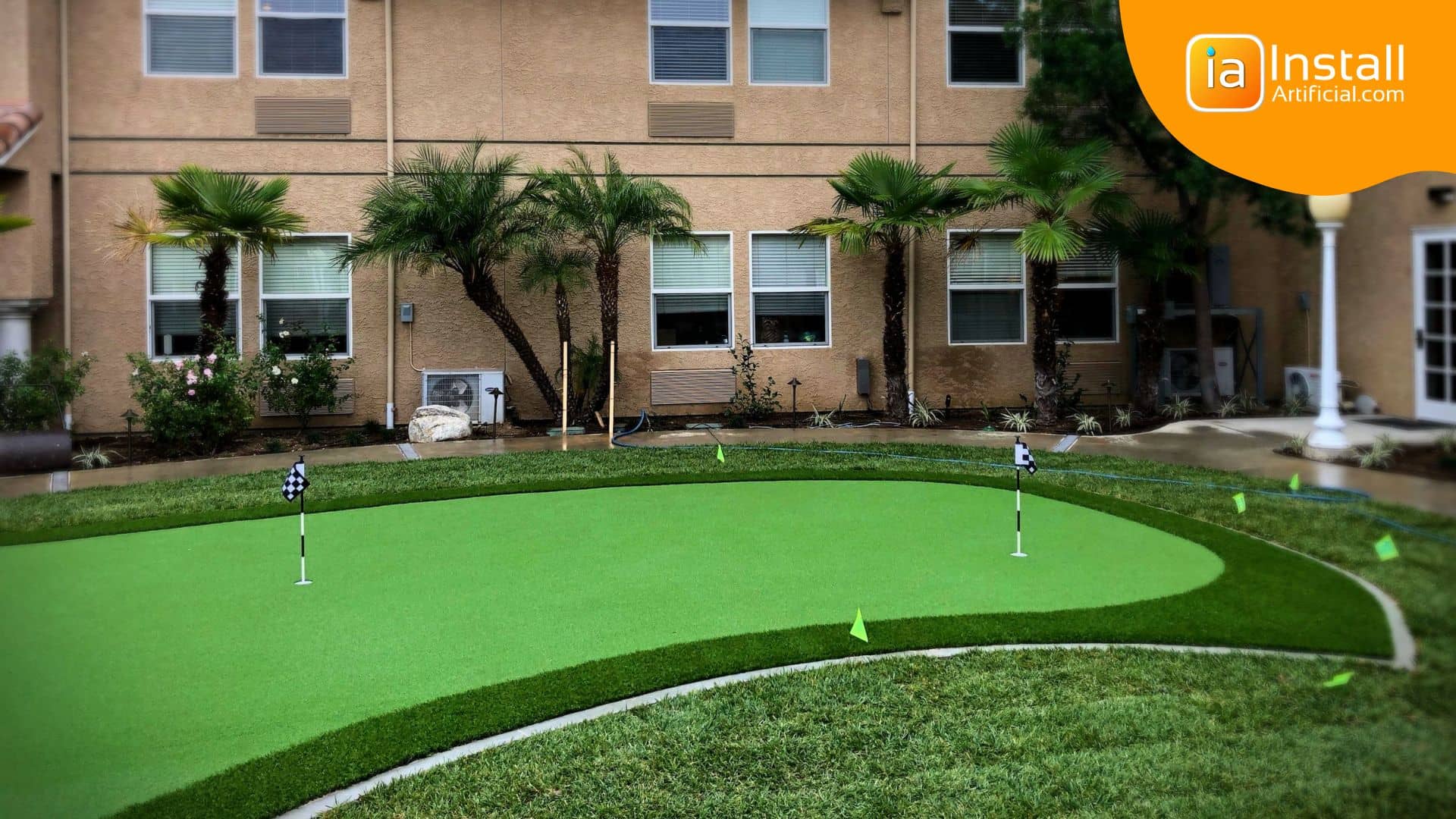
Polypropylene vs. Nylon putting green is a large debate among installers and contractors in the turf industry. Which putting green material is best for realistic golf...